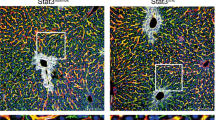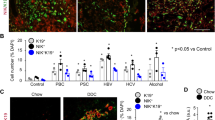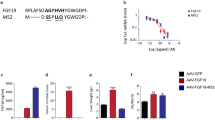Abstract
Cholangiocytes, bile duct lining cells, actively adjust the amount of cholesterol and bile acids in bile through expression of enzymes and channels involved in transportation and metabolism of the cholesterol and bile acids. Herein, we report molecular mechanisms regulating bile acid biosynthesis in cholangiocytes. Among the cytochrome p450 (Cyp) enzymes involved in bile acid biosynthesis, sterol 27-hydroxylase (Cyp27) that is the rate-limiting enzyme for the acidic pathway of bile acid biosynthesis expressed in cholangiocytes. Expression of other Cyp enzymes for the basic bile acid biosynthesis was hardly detected. The Cyp27 expression was negatively regulated by a hydrophobic bile acid through farnesoid X receptor (FXR), a nuclear receptor activated by bile acid ligands. Activated FXR exerted the negative effects by inducing an expression of fibroblast growth factor 15/19 (FGF15/19). Similar to its repressive function against cholesterol 7α-hydroxylase (Cyp7a1) expression in hepatocytes, secreted FGF15/19 triggered Cyp27 repression in cholangiocytes through interaction with its cognate receptor fibroblast growth factor receptor 4 (FGFR4). The involvements of FXR and FGFR4 for the bile acid-induced Cyp27 repression were confirmed in vivo using knockout mouse models. Different from the signaling in hepatocytes, wherein the FGF15/19-induced repression signaling is mediated by c-Jun N-terminal kinase (JNK), FGF15/19-induced Cyp27 repression in cholangiocytes was mediated by p38 kinase. Thus, the results collectively suggest that cholangiocytes may be able to actively regulate bile acid biosynthesis in cholangiocytes and even hepatocyte by secreting FGF15/19. We suggest the presence of cholangiocyte-mediated intrahepatic feedback loop in addition to the enterohepatic feedback loop against bile acid biosynthesis in the liver.






Similar content being viewed by others
References
Abrahamsson A, Gustafsson U, Ellis E, Nilsson LM, Sahlin S, Bjorkhem I, Einarsson C (2005) Feedback regulation of bile acid synthesis in human liver: importance of HNF-4alpha for regulation of CYP7A1. Biochem Biophys Res Commun 330(2):395–399. doi:10.1016/j.bbrc.2005.02.170
Babiker A, Andersson O, Lund E, Xiu RJ, Deeb S, Reshef A, Leitersdorf E, Diczfalusy U, Bjorkhem I (1997) Elimination of cholesterol in macrophages and endothelial cells by the sterol 27-hydroxylase mechanism. Comparison with high density lipoprotein-mediated reverse cholesterol transport. J Biol Chem 272(42):26253–26261
Barbier O, Torra IP, Sirvent A, Claudel T, Blanquart C, Duran-Sandoval D, Kuipers F, Kosykh V, Fruchart JC, Staels B (2003) FXR induces the UGT2B4 enzyme in hepatocytes: a potential mechanism of negative feedback control of FXR activity. Gastroenterology 124(7):1926–1940. doi:10.1016/S0016-5085(03)00388-3
Bogert PT, LaRusso NF (2007) Cholangiocyte biology. Curr Opin Gastroenterol 23(3):299–305. doi:10.1097/MOG.0b013e3280b079fb
Chen W, Chiang JY (2003) Regulation of human sterol 27-hydroxylase gene (CYP27A1) by bile acids and hepatocyte nuclear factor 4alpha (HNF4alpha). Gene 313:71–82
Chiang JY (2004) Regulation of bile acid synthesis: pathways, nuclear receptors, and mechanisms. J Hepatol 40(3):539–551. doi:10.1016/j.jhep.2003.11.006
Fava G, Glaser S, Francis H, Alpini G (2005) The immunophysiology of biliary epithelium. Semin Liver Dis 25(3):251–264. doi:10.1055/s-2005-916318
Garuti R, Croce MA, Piccinini L, Tiozzo R, Bertolini S, Calandra S (2002) Functional analysis of the promoter of human sterol 27-hydroxylase gene in HepG2 cells. Gene 283(1-2):133–143
Goodwin B, Jones SA, Price RR, Watson MA, McKee DD, Moore LB, Galardi C, Wilson JG, Lewis MC, Roth ME, Maloney PR, Willson TM, Kliewer SA (2000) A regulatory cascade of the nuclear receptors FXR, SHP-1, and LRH-1 represses bile acid biosynthesis. Mol Cell 6(3):517–526
Gupta S, Stravitz RT, Dent P, Hylemon PB (2001) Down-regulation of cholesterol 7alpha-hydroxylase (CYP7A1) gene expression by bile acids in primary rat hepatocytes is mediated by the c-Jun N-terminal kinase pathway. J Biol Chem 276(19):15816–15822. doi:10.1074/jbc.M010878200
Hay DW, Carey MC (1990) Pathophysiology and pathogenesis of cholesterol gallstone formation. Semin Liver Dis 10(3):159–170. doi:10.1055/s-2008-1040470
Holt JA, Luo G, Billin AN, Bisi J, McNeill YY, Kozarsky KF, Donahee M, Wang DY, Mansfield TA, Kliewer SA, Goodwin B, Jones SA (2003) Definition of a novel growth factor-dependent signal cascade for the suppression of bile acid biosynthesis. Genes Dev 17(13):1581–1591. doi:10.1101/gad.1083503
Inagaki T, Choi M, Moschetta A, Peng L, Cummins CL, McDonald JG, Luo G, Jones SA, Goodwin B, Richardson JA, Gerard RD, Repa JJ, Mangelsdorf DJ, Kliewer SA (2005) Fibroblast growth factor 15 functions as an enterohepatic signal to regulate bile acid homeostasis. Cell Metab 2(4):217–225. doi:10.1016/j.cmet.2005.09.001
Jung D, Kullak-Ublick GA (2003) Hepatocyte nuclear factor 1 alpha: a key mediator of the effect of bile acids on gene expression. Hepatology 37(3):622–631. doi:10.1053/jhep.2003.50100
Liu YP, Binz J, Numerick MJ, Dennis S, Luo GZ, Desai B, MacKenzie KI, Mansfield TA, Kliewer SA, Goodwin B, Jones SA (2003) Hepatoprotection by the farnesoid X receptor agonist GW4064 in rat models of intra- and extrahepatic cholestasis. J Clin Investig 112(11):1678–1687. doi:10.1172/Jci18945
Modica S, Gadaleta RM, Moschetta A (2010) Deciphering the nuclear bile acid receptor FXR paradigm. Nucl Recept Signal 8:e005. doi:10.1621/nrs.08005
Modica S, Petruzzelli M, Bellafante E, Murzilli S, Salvatore L, Celli N, Di Tullio G, Palasciano G, Moustafa T, Halilbasic E, Trauner M, Moschetta A (2012) Selective activation of nuclear bile acid receptor FXR in the intestine protects mice against cholestasis. Gastroenterology 142(2):355–U269. doi:10.1053/j.gastro.2011.10.028
Moschetta A, Bookout AL, Mangelsdorf DJ (2004) Prevention of cholesterol gallstone disease by FXR agonists in a mouse model. Nat Med 10(12):1352–1358. doi:10.1038/Nm1138
Popowski K, Eloranta JJ, Saborowski M, Fried M, Meier PJ, Kullak-Ublick GA (2005) The human organic anion transporter 2 gene is transactivated by hepatocyte nuclear factor-4 alpha and suppressed by bile acids. Mol Pharmacol 67(5):1629–1638. doi:10.1124/mol.104.010223
Raingeaud J, Gupta S, Rogers JS, Dickens M, Han J, Ulevitch RJ, Davis RJ (1995) Pro-inflammatory cytokines and environmental stress cause p38 mitogen-activated protein kinase activation by dual phosphorylation on tyrosine and threonine. J Biol Chem 270(13):7420–7426
Rao YP, Vlahcevic ZR, Stravitz RT, Mallonee DH, Mullick J, Avadhani NG, Hylemon PB (1999) Down-regulation of the rat hepatic sterol 27-hydroxylase gene by bile acids in transfected primary hepatocytes: possible role of hepatic nuclear factor 1alpha. J Steroid Biochem Mol Biol 70(1-3):1–14
Sinal CJ, Tohkin M, Miyata M, Ward JM, Lambert G, Gonzalez FJ (2000) Targeted disruption of the nuclear receptor FXR/BAR impairs bile acid and lipid homeostasis. Cell 102(6):731–744
Sinha J, Chen F, Miloh T, Burns RC, Yu Z, Shneider BL (2008) beta-Klotho and FGF-15/19 inhibit the apical sodium-dependent bile acid transporter in enterocytes and cholangiocytes. Am J Physiol Gastrointestin Liver Physiol 295(5):G996–G1003. doi:10.1152/ajpgi.90343.2008
Song KH, Li T, Owsley E, Strom S, Chiang JY (2009) Bile acids activate fibroblast growth factor 19 signaling in human hepatocytes to inhibit cholesterol 7alpha-hydroxylase gene expression. Hepatology 49(1):297–305. doi:10.1002/hep.22627
Strazzabosco M, Fabris L, Spirli C (2005) Pathophysiology of cholangiopathies. J Clin Gastroenterol 39(4 Suppl 2):S90–S102
Tietz PS, Chen XM, Gong AY, Huebert RC, Masyuk A, Masyuk T, Splinter PL, LaRusso NF (2002) Experimental models to study cholangiocyte biology. World J Gastroenterol 8(1):1–4
Tietz PS, Larusso NF (2006) Cholangiocyte biology. Curr Opin Gastroenterol 22(3):279–287. doi:10.1097/01.mog.0000218965.78558.bc
Twisk J, de Wit EC, Princen HM (1995) Suppression of sterol 27-hydroxylase mRNA and transcriptional activity by bile acids in cultured rat hepatocytes. Biochem J 305(Pt 2):505–511
Vlahcevic ZR, Jairath SK, Heuman DM, Stravitz RT, Hylemon PB, Avadhani NG, Pandak WM (1996) Transcriptional regulation of hepatic sterol 27-hydroxylase by bile acids. Am J Physiol 270(4 Pt 1):G646–G652
Wang L, Lee YK, Bundman D, Han Y, Thevananther S, Kim CS, Chua SS, Wei P, Heyman RA, Karin M, Moore DD (2002) Redundant pathways for negative feedback regulation of bile acid production. Dev Cell 2(6):721–731
Wittenburg H, Lyons MA, Li R, Churchill GA, Carey MC, Paigen B (2003) FXR and ABCG5/ABCG8 as determinants of cholesterol gallstone formation from quantitative trait locus mapping in mice. Gastroenterology 125(3):868–881
Xia X, Jung D, Webb P, Zhang A, Zhang B, Li L, Ayers SD, Gabbi C, Ueno Y, Gustafsson JA, Alpini G, Moore DD, Lesage GD (2012) Liver X receptor beta and peroxisome proliferator-activated receptor delta regulate cholesterol transport in murine cholangiocytes. Hepatology 56(6):2288–2296. doi:10.1002/hep.25919
Xie MH, Holcomb I, Deuel B, Dowd P, Huang A, Vagts A, Foster J, Liang J, Brush J, Gu Q, Hillan K, Goddard A, Gurney AL (1999) FGF-19, a novel fibroblast growth factor with unique specificity for FGFR4. Cytokine 11(10):729–735. doi:10.1006/cyto.1999.0485
Yang Y, Zhang M, Eggertsen G, Chiang JY (2002) On the mechanism of bile acid inhibition of rat sterol 12alpha-hydroxylase gene (CYP8B1) transcription: roles of alpha-fetoprotein transcription factor and hepatocyte nuclear factor 4alpha. Biochim Biophys Acta 1583(1):63–73
Yu C, Wang F, Kan M, Jin C, Jones RB, Weinstein M, Deng CX, McKeehan WL (2000) Elevated cholesterol metabolism and bile acid synthesis in mice lacking membrane tyrosine kinase receptor FGFR4. J Biol Chem 275(20):15482–15489
Zhang M, Chiang JY (2001) Transcriptional regulation of the human sterol 12alpha-hydroxylase gene (CYP8B1): roles of hepatocyte nuclear factor 4alpha in mediating bile acid repression. J Biol Chem 276(45):41690–41699. doi:10.1074/jbc.M105117200
Zweers SJ, Booij KA, Komuta M, Roskams T, Gouma DJ, Jansen PL, Schaap FG (2012) The human gallbladder secretes fibroblast growth factor 19 into bile: towards defining the role of fibroblast growth factor 19 in the enterobiliary tract. Hepatology 55(2):575–583. doi:10.1002/hep.24702
Acknowledgments
This work was supported by grants from the National Institutes of Health (R01 DK53366 to D.D.M., RC4 DK90849 to P.W., R01 DK54208 to G.D.L., R01 DK080440 to L.W., R01 DK062975, and DK76898), from the Dr. Nicholas C. Hightower Centennial Chair of Gastroenterology from Scott & White Hospital to G.A., and from the National Natural Science Foundation of China (no. 81270868 to X.X.).
Conflict of interest
None.
Author information
Authors and Affiliations
Corresponding author
Additional information
Dongju Jung and J. Philippe York contributed equally to this work.
Rights and permissions
About this article
Cite this article
Jung, D., York, J.P., Wang, L. et al. FXR-induced secretion of FGF15/19 inhibits CYP27 expression in cholangiocytes through p38 kinase pathway. Pflugers Arch - Eur J Physiol 466, 1011–1019 (2014). https://doi.org/10.1007/s00424-013-1364-3
Received:
Revised:
Accepted:
Published:
Issue Date:
DOI: https://doi.org/10.1007/s00424-013-1364-3




